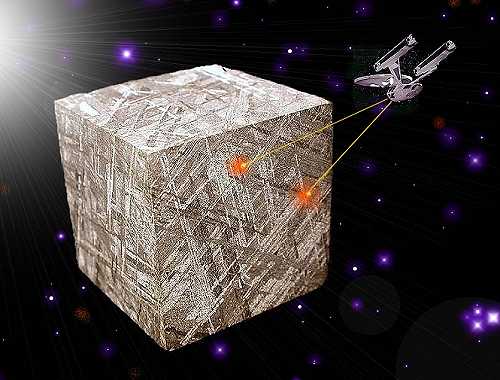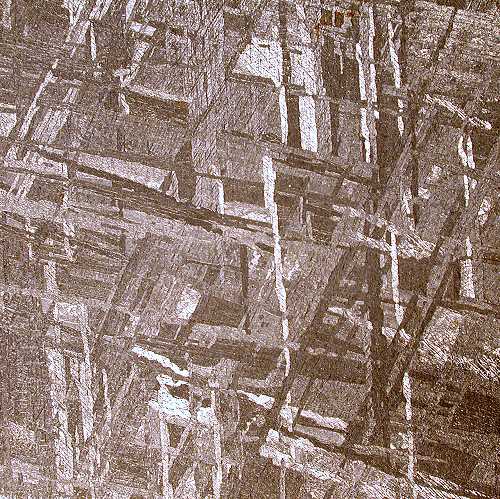|
January, 2003 |
|
||||||||||||||||||||||||||||||||||||
Lab Photo HomepageOn--Line CatalogSite Express |
. . . .Borg ? . . or how vugs formed in iron meteorites?
While resembling the infamous "Borg" from Paramount's Star Trek, this is actually a piece of an iron meteorite. It's been sectioned into a perfect cube, polished, and etched to show the Ni/Fe intergrowth. Iron meteorites are the mineralogical end product of planetary (generic, includes asteroidal) differentiation. Of all the meteorites available for study, they represent the largest mass proportion of extraterrestrial material available here on Earth. A typical iron meteorite consists mostly of iron with 5 to 25% Nickel (San Cristobal, 25.6% Ni). While there are upward exceptions to this ratio there are no authenticated iron meteorites known to contain less than 4% Ni. Many iron meteorites, when acid etched, reveal a texture historically referred to as the Widmanstatten pattern. This is an intergrowth of several phases of body-centered cubic iron (Fe) and Nickel (Ni). This pattern is associated with Alois Beckh von Widmannstatten but was first discovered independently by G. Thompson and E.C. Howard in the first decade of the 19th century. (the German spelling, always following the spelling of the proper name, uses "nn" while papers in English always refer to "Widmanstatten structure" with a single "n" ). 
The formation of the Widmanstatten structure (crystallization of Ni/Fe) seen above is the result of an asteroidal core cooling very slowly over millions of years. The following chart, helpful in cooling rate data, shows an association between group, cooling rate, and parent body radius, and is a distillation of data from referenced researchers* .

|
||||||||||||||||||||||||||||||||||||
|
Rarely observered and poorly understood is the presence of "vugs" or small multi-millimeter-sized irregular cavities in some iron meteorites(Albion). These cavities are sometimes lined with drusy spheroidal masses, blocky euhedral grains of daubreelite and euhedral schreibersite indicating the passage of reactive fluid phases during one or more episodes of its history. Visually intriguing, iron meteorites are Ni/Fe pieces from the core of large, differentiated asteroids disrupted by collision. They are, in a sense, asteroidal debris from which much has been learned about planetary differentiation. Additional reading for formative modeling, chemical composition, minor and trace elemental abundances: Buchwald, V.F., 1975, "Handbook of Iron Meteorites, Their History, Distribution, Composition, and Structure", Vol. 1, 2, 3. Papike, J.J., 1998, "Planetary Materials", Reviews in Mineralogy, Vol 36 Referenced researchers: Yang et al. (1997a), Rasmussen (1989), Scott (1977a), Haack et al. (1990), Randich and Goldstein (1978) |
|||||||||||||||||||||||||||||||||||||
This document maintained by
staff@meteorlab.com. |
|||||||||||||||||||||||||||||||||||||

